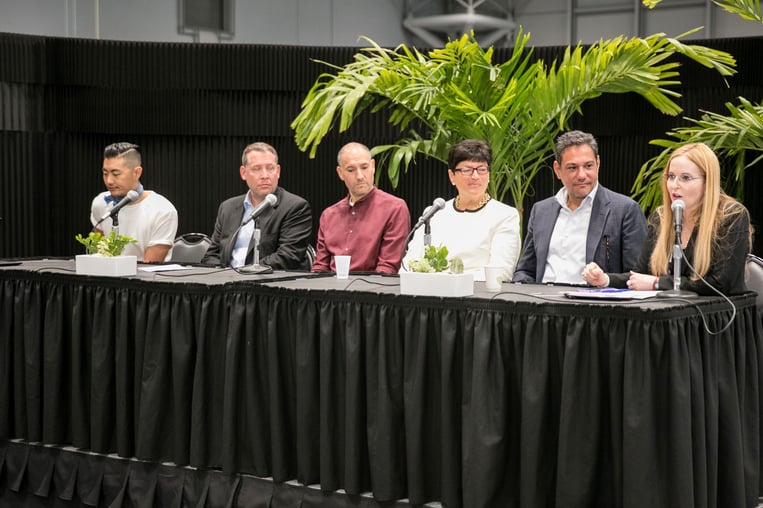
On Monday, July 18, at the entirely civilized time of 7:30 am, UBM president of men’s Erik Ulin and Luis Fernandez gathered a panel of FashionTech ‘disruptors’ together at the Project trade show to discuss the influence of technology on fashion, and how to stay current in an industry increasingly affected by the world’s seismic advances in technology. Moderated by head of Fung Global Retail & Technology Deborah Weinswig, the panel included Greg Petro, CEO and founder of First Insight, David Yi, fashion editor at Mashable, Lisa Gavales, CEO of Things Remembered, Scott Lux, VP of digital and e-commerce at John Varvatos, and Joe Ferrara, founder of Ferrara Manufacturing Company. If you were still in bed unable to attend for whatever reason, never fear, I was there taking comprehensive notes, for your educational reading pleasure below:
Greg: The first thing to keep in mind is that while unit prices are decreasing in the menswear industry, unit sales are increasing. When we were the tech partner of WWD, we noticed that the menswear segment performed well year after year, but it was trading profit margin for market sales. The contemporary consumer has a notion that value is related to price and that isn’t exactly true. The challenge is getting ahead of that curve and understanding which products are going to do well in the market.
Joe: We invested in Tommy John, and thank god, since it’s one of the categories that’s not part of the downward pricing spiral. If you have the right product that has a point of difference and connects with your customers you can still command that top-tier price. If you think of men’s underwear, it’s black, grey and white. We need stars and stripes, we need colors, performance fabrics like wicking for example, which is a premium offering. Doing those things, you can maintain that premium price.
Scott: We’ve been working on really getting back to the basics. There are so many tech options in the sector, it’s hard not to go after every shiny object. Making sure that we run in-depth analytics so we know that the tech we implement is going to have benefits for our customer is important. I think there’s a huge opportunity to reconnect with your customers using the tech options available. Millennials want to have that emotional connection which has in some ways been lost in digital. The challenge is to uncover what’s relevant for our consumers. What’s the benefit for our end consumer and will it have a direct benefit for them?
David: Fashion has become such a democratized industry. From Indiegogo to Kickstarter where customers can feel like they have an actual investment in the brand. Whether Gen X or Millennial, we can instantly see what’s trending among those customers. Whether they’re 16 or 64, African-American, etc. We can’t shy away from analytics.
Greg: Analytics and data are a component, but you still have to be authentic to your brand and your consumer. Any data that’s giving you a forward look is important, and then balancing that with intuition. It’s interesting as we explore each generation. The data about them is more and more available. And increasingly customers who would have shied away from giving retailers and brands information and feedback, actually want those people to understand them better: they engage, which allows a very authentic relationship of talking and listening.
Lisa: When I got to Things Remembered, we’re a 50-year-old company, and we had a niche. But we needed to figure out what else we could sell, figure out what the brand could mean as the landscape changed. Sometimes it’s hard to know what legs your brand has. We used First Insight to figure that out. The ads for things you were just looking at is still a little creepy but it works. Everyone thought that opting out of everything was the answer, but actually there are huge benefits to letting brands know what you like. If you knew what Google knows about you you’d be creeped out, but it’s a fine line and we’re walking it.
Scott: Customers are open to having communication with brands and retailers if it has value for them. As brands continue to provide more value, a little more storytelling so it isn’t just pushing product is important as you interact with different touch points of the brand.
Joe: Community is good but microcommunity is better. As engagement goes up your segment of community gets narrower. That’s not a bad thing, that’s a good thing. That relationship of narrow community with wide engagement is the best: 10,000-100,000 engaged customers, and being very on message and entirely engaged with them. Build those communities. And as for the ‘creep factor’, deploy the creep factor to the max and don’t hold back. Stalking is fine. We have such granular information on customers: if they’re all XXL and buying XL, they go to church, they’re from Texas, they’re married: feed that data into the next launch or create hyper-focused content for those customers. Don’t be afraid to shave down into microcommunities, which is at the heart of microsegmentation.
David: Millennials are boring, dead, so if you haven’t reached them and you don’t understand them it’s too late. It’s all about Gen Z. They’re so much cooler. They delete their Instagrams and they don’t put their Snapchat stories for everyone to see. They’re empowered by who they are, they’re gender fluid and they want to have their own mind and become their own individual self. In their households they’re influencing $600 billion in commerce a year. They aren’t brand loyal, they don’t care about quality: they care about social cache, like Vetements and Yeezy: are they the best shoes money can buy? No. Are they the best on social media? Yes. Let’s say goodbye to Millennials: they’re dead.
Greg: I was talking to a bunch of technologists recently, and their argument was that we’re discovering Millennials at a specific stage in life and we’re doing so because the data and technologies are available. That data and technology wasn’t available in previous generations, so perhaps we’ll learn that there are more inherent patterns of behavior that we all go through as we grow up, and that it isn’t generational but more age and the stages of life. I talked to the chief scientist at Amazon. The person that buys a blue shirt doesn’t want to keep seeing a blue shirt so what’s next? We have to figure out a way to tap into that.
Joe: It’s all about personalization and micro segmentation. Those two words should be in your boardroom and on your planning board.
Greg: The two most important things are customer segmentation and testing products. If you don’t get the right products in front of your consumers it’s a problem. They have to resonate with the customer. In menswear, 63 percents of products fail. Women’s wear is worse and footwear’s the hardest. Augmented reality in store locations and on mobile devices is the future. Everyone will have augmented reality in their stores and online, and if your offers aren’t the right ones they’ll delete you.
David: In the future we can’t ignore wearable tech. I’m talking about the retail experience too, VR technology. What is that and how can we translate that? And mobile commerce. Why are people still hesitant to use Apple Pay? The Apple Watch? Does it really enhance my life, no? But the social cache is why I’m wearing it. We have to figure out how we marry those things. That is our future.















